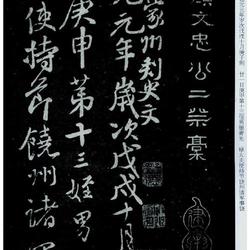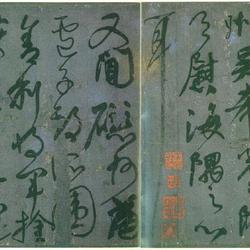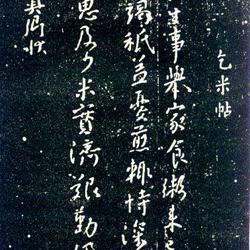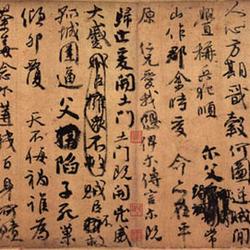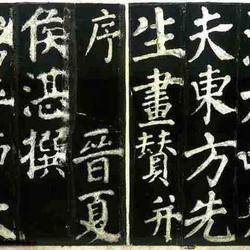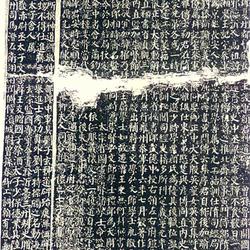Also known as "Tie on Zuo Tie" and "Book with Guo Pu She". It is a masterpiece of Yan Zhenqing's cursive calligraphy, written in November of the second year of Emperor Guangde's reign (764). manuscript.
This post is a manuscript of the correspondence between Yan Zhenqing and Shangshu Youpuse and Guo Yingyi, the king of Dingxiang County. The biography consists of seven pages with approximately 64 lines. The letter bluntly accused the relegated Guo Yingyi of flouting etiquette at two grand gatherings and flattering the eunuch Yu Chaoen, so that the courtesy was higher than that of the six ministers, and the eunuch's seat was elevated. For this reason, Yan Zhenqing cited the conventions of past dynasties and the Tang Dynasty to fight against it, and wrote this long letter. What is particularly noteworthy is that Yu Chaoen was a powerful, arrogant and domineering figure at the time, and was looked down upon by both the government and the public. Yan Zhenqing's rebuke dampened his arrogance, so the world called this manuscript "The Fight for Seats". This manuscript is a work written by Yan Zhenqing because he was dissatisfied with the arrogance and domineering power of the traitor. The whole article is full of staunch and vigorous spirit, full of energy, open-minded and open-minded. The words are filled with a bright and loyal spirit, which shows that Yan Zhenqing is strong, upright, simple and honest. character. It has been more than a thousand years since it was written, and it is awe-inspiring to read it.
Mi Fu said in "History of Calligraphy": "The Calligraphy for Fighting for Seats has the spirit of seal script and is the best in Yan's calligraphy. The words are connected and the strange movements are caused by accidents." "This calligraphy is the most outstanding in Yan's writing. I think of it. Loyalty and anger, frustration and frustration, the meaning is not in the words, the innocence is revealed in this book." This post was originally a draft. The author meditated on the words and sentences. He did not pay attention to the pen and ink, but the paper was full of vitality. , has become a masterpiece in the history of calligraphy and one of the best examples of running cursive. Su Shi once saw the original work at Chang'an's house in the Northern Song Dynasty and praised it: "This calligraphy is even more unique than other calligraphy works by Gong. It is written by one's own hand and has gestures in movement."
This post was originally an old relic of An Shiwen from Chang'an in the Northern Song Dynasty, and it was engraved and handed down to the world. Later, the An brothers analyzed their family's wealth and cut the original work into two. Later, he entered the inner palace and never saw the outside world again. The inner palace was also tossed and turned without knowing where it ended up, and no real remains were seen in the world. The original traces have been lost. An Shiwen's stone carvings are based on original imitations. The stone carvings are now stored in the second room of the Forest of Steles in Xi'an. They are square and vertical, 107.5 x 69.5 cm. The book is divided into two sections, each with 36 lines. At this time, the stone world is called "Guanzhong Edition" and "Shaanxi Engraved Edition". Because of the exquisite imitation and the loss of the original work, interested parties used this copy as a basis for repeated engravings. There are as many as 12 types of imitations and engravings handed down from generation to generation. Therefore, among all the books handed down from generation to generation, this is the most important. Today, rubbings from the Northern Song Dynasty are no longer handed down, and rubbings from the Southern Song Dynasty are also as rare as stars. Among them, the Northern Song Dynasty calligraphy collections in the National Library, the Imperial Palace Museum in Beijing, and the Southern Song rubbings in the Shanghai Library are relatively famous.
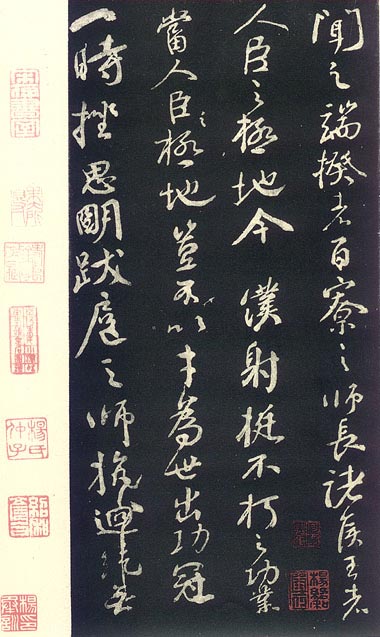
Collection of the Palace Museum, Beijing
释文;十一月 日,金紫光禄大夫检校邢部尚书上柱国鲁郡开国公颜真卿,谨奉寓书於右仆射定襄郡王郭公阁下,盖太上有立德,其次有立功,是之谓不朽。抑又闻之,端揆者,百寮之师长。诸侯王者,人臣之极地,今仆射挺不朽之功业,当人臣极地。岂不以才为世出,功冠一时。挫思明跋扈之师,抗回纥无厌之请,故得身画淩烟之阁,名藏太宝之廷,吁足畏也。然美则美矣,然而终之始难。故曰:满而不溢,所以长守富也。高而不危,所以长守贵也。可不儆惧乎?书曰:尔唯弗矜,天下莫与汝争功。尔唯不伐,天下莫与汝争能。以齐桓公之盛业,片言勤王,则九合诸侯,一匡天下。葵丘之会,微有振矜,而叛者九国。故曰:行百里者半九十里,言晚节未路之难也。从古至今,自我高祖太宗已来,未有行此而不理,废此而不乱者也。前者菩提寺行香,仆射指麾宰相与两省三省已下常参官并为一行坐,鱼开府及仆射率诸军将为一行坐,若一时从权,亦犹未可。何况积习更行之乎?一昨以郭令公父子之军,破犬羊凶逆之众,众情欣喜,恨不顶而戴之。是用有兴道之会,仆射又不悟前失。径率意而指麾,不顾班秩之高下,不论文武之左右,苟以取悦军容为心。曾不顾百寮之侧目,亦何异清画攫金之士哉?甚非谓也。君子爱人以礼,不窃见闻姑息。仆射得不深念之乎?真卿偶闻军容之为人,清修梵行,深入佛海,况乎收东京有殄城之业,守陕城有戴天之功,朝野之人,所共景仰,岂独有分於仆射哉。加以利衰涂割,恬然於心。固不以一毁加怒,一敬加喜。尚何半席之座咫尺之地能泊其志哉。且卿裏上齿,宗庙上爵,朝廷上位,皆有等威,以明长幼。故得彝伦叙而天下和平也。且上自宰相御史大夫两省五品以上供奉官自为一行,十二卫大将军次之。三师三公令仆射少师保傅尚书左右侍郎自为一行,九乡三监对之,从古以然,未尝参错,至如节度军将,各有本班卿监之班。将军有将军位,纵是开府特进,并是勋官,用荫即有高卑,会燕合依伦叙,岂可裂冠毁冕,反易彜伦,贵者为卑所凌,尊者为贱所逼,一至於此,振古未闻。如鱼军容阶虽开府,官即监门将军,朝廷列位,自有次叙,但以功绩既高,恩泽莫二,出入王命,众人不敢为此,不可令居本位,须别示有尊崇,只可于宰相师保座南,横安一位,如御史台众尊知难事御史,别置一榻,使百寮共得瞻仰,不亦可乎?圣皇时,开府高力士承恩傅宣,亦只如此横座,亦不闻别有礼数。亦何必令他失位,如李辅国倚承恩泽,径居左右仆射及三公之上。令天下疑怪乎?古人云:益者三友,损者三友,愿仆射与军容为直谅之友,不愿仆射为军容佞柔之友。又一昨裴仆射误欲令左右承勾尝尚书,尝时辄有训对。仆射恃贵,张目见尤,介众之中,不欲显过。今者与道之会,还尔遂非,再谒八座尚书,欲令便向下座。州县军城之礼,亦恐未然。朝廷公宴之宜,不应若此。今既若此,仆射意只应以为尚书之与仆射。若州佐之与县令乎?若以尚书同于县令,则仆射见尚书令,得如上佐事刺史乎?益不然矣。今既三厅齐列,足明不同刺史且尚书令与仆射,同是二品,只校上下之阶,六朝尚书并正三品,又非隔品致敬之类。尚书之事仆射礼数未敢有失。仆射之顾尚书,何乃欲同卑吏?又据宋书有百官志,八座同是第三品,隋及国家始升,别作二品。高自标致,诚则尊崇,向下挤排,无乃伤甚况再於公堂,猲咄常伯,当为令公初到,不欲纷披,黾勉就命,亦非理屈。朝廷纪纲,须共存立,遇尔隳坏,亦恐及身。明天子忽震电含怒,责毂彜伦之人,则仆射其将何辞以对。
附录:震魂慑魄的行草书巨卷交响── 颜真卿《争座位帖》评析(作者:崔学路)
历代书法中。 最接近 “人心本田”、 “书为心迹”的行草书巨卷, 当首推唐代书法巨宗--颜真卿的行草书稿《争座位帖》了。
颜真卿的行草书稿《争座位帖》手稿久已不存. 幸历代书家宝之。 争相刊石传世, 刻石竟十之有二, 为它帖所绝无。 遂使中国书坛有了标拔行草高度--直视人之本心、书写意绪的不朽行草巨卷得以遗世显彰, 此真天之幸也、书坛之幸也。
《争座位帖》是颜真卿56岁时于唐广德二年(764)十一月十四日写给仆射郭英乂的直诤书稿。 鲁公出于对朝廷纪纲的维护、对功臣秉义的佑护、对奸佞骄横的摧折书写此稿, 忠义之气充之于心、赋之于文、形之于书, 全篇理正、词严、文厉、书愤,洋洋千文, 如长水蹈海, 无可阻挡, 遂使历代书家无不为之服膺倾倒。
尚意的“宋四家”之首苏东坡最为推崇鲁公书, 尊为书之极至。 傲啸书坛的狂逸之士--米南宫于颜楷鄙为“恶札之祖”, 然于鲁公《争座位帖》、《祭侄文稿》且绝无微词, 而盛赞之为“字字意相连属飞动, 诡形异状, 得于意外, 世颜行书第一书也”。宋代行草书能与唐室抗行的唯一一人--黄鲁直更能直接道出“观鲁公其帖,奇伟秀拔, 奄有晋隋唐来风流气骨。回视欧、虞、褚、薛、徐 沈辈,皆为法度所窘。岂如鲁公肃然出于绳墨之外......盖自二王后能书法之极者, 唯张长史与鲁公二人”, 真谓至言也。
In the remaining decades, every time I read this post, I felt that Lu Gong had no intention of writing it, but that his state of mind naturally resided in the book. It can be said that "the book has no formula, the chapters are not fixed, the chapters are ups and downs, and the structure is natural". It is the "magnificent epic and giant symphony" of our country's cursive script.
1. Prologue: The Underworld of Reason
"The Fight for a Seat" begins with the first line of "November" and gradually expands to 17 lines of "Explaining the difficulties of the end of the evening festival", which is the preface to the manuscript of Lu Gong's book.
The first line of writing is like a heart spring flowing out of a valley, gurgling out, showing a hint of sharpness despite its calmness. The second line of writing is scattered and swaying, and the third line has seen ups and downs to stimulate the mood, establishing a strong character for the entire writing style.
The four to twelve lines of this paragraph are Lu Gong's statement to Guo Yingyi. It is written coldly and gradually with anger. The conflict is hidden under the rational description. The words are high-spirited and the atmosphere is thick. The sound of rolling thunder comes from the sky and shakes the eardrums. When Lu Gong's book reaches the sentence "It's fearful to call out, but beauty is beautiful but the beginning is difficult", the excitement in his heart gradually parallels the rational statement. The eleven lines of "Gu Yue" are written firmly and solidly, laying a solid and powerful first impression on the debate. The last paragraph of argumentation is written like flowing clouds and flowing water, adding a lyrical adagio to the sonorous excitement. From the 13th to the 17th line, Lu Gong is in the stage of "expounding the classics and setting out the principles". Starting from "Book Saying" and then the next five lines, the meaning of writing is dense and long, eloquent to the world, and citing the sage and wisdom of ancient and modern times. As a result, Lu Gong's manuscript beat the shocking war drums of the first movement in the strong performance of "big rhythm, strong stomping, and stretching of the crossbow", establishing a powerful introduction of "preemption" for the dense narrative of the next chapter.
After the vigorous stomping and beating of drums in the first stage of Lu Gong's "Composition to Fight for Seats", there was an almost dead silence in the manuscript where the calligrapher paused.
Then, Lu Gong brushed away the suppressed silence and once again raised the true uproar in his heart. It is the text, it is the book that eagerly incorporates the second movement of the argument.
2. On-topic: Indignant Contempt
The second movement begins with the 18-line sentence "From ancient times to the present". The word shapes are gathered together, which shows that Lu Gong used pen to rewrite the events from the distant and distant time and space. The words are fast and mysterious, showing Lu Gong's mood. The narrative skills are rigorous, unobstructed, free-flowing, and coherent. The pen, structure and calligraphy of this paragraph are completely different from the Qingyi style of Jin and Sui Dynasties, and it depicts Lu Gong's "powerful and dense" personal appearance. This paragraph directly refers to the fact that Pushe Guo Yingyi "regardless of the rank of the class and the control of civil and military affairs" flattered treacherous eunuchs, humiliated loyal ministers, and arranged seats randomly. To the book, "I have always wanted to please the military appearance, and I have ignored the sideways glances of hundreds of officials. How can I be different from the men who grabbed gold in the Qing Dynasty?" The words are exciting, the writing is clear, and it goes straight to the heart of the traitor. Especially in the last sentence, both numbers and glyphs are displayed, which suddenly shows the open and exciting heart. The truth will not be enough for thousands of years - and the charm will never be able to reach the realm of great truth. The next line is full of swaying and dancing, adding a lively and free image to the strong and upright character. When he reaches the sentence "The real Qing heard about the military appearance...", the anger increases again, the strokes become stronger, the words are square and round, and the words are broad and wide, and then the second climax of the whole article is gathered.
The drums in Lu Gong's heart were beating again, and the waves were rising again. The vastness of the meaning surges from the heart, and the force pours into the pen, giving people a heart-breaking shock. However, the sentences from "Pursuing the holy practice in the Qing Dynasty and going deep into the sea of Buddha" to "It is enough to stir up one's ambitions" are written word by word. They may be upright and slanted, zigzag and straight again, and have strange ups and downs, which constitute the composition of Dulu Gong. And Neng Chen's wonderful chapter.
However, Lu Gong didn't stop there, and added a few small words between the lines to add meaning. Pingdijian broke the previous balance between the lines, suddenly adding density to the sparse lines, and adding tightness to the melody of the great movement. "polyphony". These small characters are written freely, such as "stairs are paved with stones, both straight and oblique, and laid out according to the situation", which shows Lu Gong's extraordinary ability to "see the strange in the ordinary and the big in the small". In addition, the long hook curve outline on the left side of the word "Buddha Sea", the painting is like an "iron halberd in the sinking sand" twisting and bending, stubbornly waving it with all its strength, and the meaning of "Long Live Withered Vine" is derived from this stroke. Taking full advantage of it is to know that future generations will never be able to achieve great power again, which is awe-inspiring. Lu Gong's powerful moves such as great connections, great destruction, and great collisions established a lofty status that would never be seen again after him.
The theme of "Fighting for Seats" is indeed highlighted in the argumentative arguments in lines 30 to 51 in the middle section. The content of the text and the outpouring of emotions are integrated into one, and "the book is the voice of the heart" appears together. It is a "symphonic masterpiece" written in cursive script of written history, roaring, trembling, and constantly shaking the hearts of subsequent people.
3. Main title (Main drama) A golden spiritual catharsis
The entry point of this topic should be from the end of the thirteenth line "Qie Xiang Li Shang Te" to the fifty-first line "I don't want to serve as a friend of the army Rong Ningrou". Lu Gong's writing has changed from an agitated eruption to a wise and rational statement. Rational narration rekindles the fire of justice in the heart. Text, calligraphy, theory and meaning overlap and form the splendid theme of the movement.
"From the prime minister" and then the next four lines discuss the principles of official rank, superiority and inferiority of seats. The writing is organized and orderly. The writing is completely devoid of anger, tight and impeccable, showing Lu Gong's dahua state of being at ease and perfectly rounded.
Especially the words "Since ancient times, there has never been a wrong combination" and the last two lines, the writing is moved by emotion. The whole line of characters is staggered, stretched and contracted, written in large strokes, and becomes more and more sparkling. It shows that Lu Gong wrote his intention with ease and grace, and played the whole piece of Lu Gong's colorful movement with different movements and manifestations.
However, when the book reaches the passage of "Zong is the special advancement of the government" to the "unheard-of theory in ancient times" and denounces traitors, Lu Gong's writing style suddenly becomes strict and square, and the strokes are arranged and organized, and the painting is thick and straight. , the structure is tight and neat; the Qi flows from top to bottom, without causing any part of the painting to be flaring out or letting any place become deflated, forming a solemn feeling of a neat, solid and upright pillar holding up the sky. The long calligraphy scroll has now entered a stage of emotion that is simple, vigorous, and moving forward as a whole.
The book ends with "The imperial court seats are arranged in their own order" and then there are nine lines in total, which is the stage where Lu Gong fully described the original intention and traces from the heart. The more than 100 characters in the entire paragraph are all written in a convoluted and rounded way. The fortitude contains the roundness of the seal script and the dignified writing style. From this, the original meaning of Lu Gongxing's manuscript is most evident.
When Lu Gong wrote a calligraphy, he always followed his heart and never used the same painting, the same word, or the same line. For example, in the line "The seats have their own order", the characters are of different sizes, weights, pitches and postures, and each has its own posture; "The seats have their own order" are written in six words, but they are clear and clear; "But "His achievements are high", the six-character shape suddenly expands, the spacing of the characters is sparse, and it is written purely with a clumsy and heavy brushwork. The brush strokes are firm, the drawings are solid, the bones are strong and the flesh is plump; and the sentence "Enze Dian Er", He also picked up his pen and wrote in a continuous style. There are three sentences in one line and three meanings. From this, we can see that Lu Gong accused his servant Guo Yingyi of arranging loyalties and flattering sycophants and arranging seats randomly. Quoting "an ancient saying: There are three friends who benefit and three friends who harm", and exhaled the words "I hope Pu She will be a friend who forgives the military appearance, but I don't want Pu She to be a friend who has a treacherous military appearance". The fire of righteousness in my heart is high, and the spirit of loyalty is renewed again. High. As a result, the momentum of the brushwork is unstoppable, and the brushstrokes flow and become intense. Lu Gong's "house leakage mark" method is fully demonstrated here. The writing of this paragraph is like a stream of light flowing across the eyes and melting gold flowing to the ground. The flow of the round lines clearly illustrates the bright and bright soul of Liu Lu Gong.
Yan Lugong angrily denounced Guo Yingyi and Yu Chaoen as friends of sycophants. The topic has been passed and should be stopped. However, Lu Gong failed again due to the failure of Ju Guo, Yu, and Er Cheng, so there were sequels one after another, forming an alternating display of trends, texts, and books, and the book was like music and a new trend emerged again.
Four Sequels: Repeated surges of heart
"Fighting for Seats" starts with the sentence "Another yesterday...", the theme passes, and a continuation of the sound is added, which is another climax of the symphony.
Then five lines of writing with nearly a hundred characters showed that Lu Gong was furious again. The continuous cursive writing of the three characters "Fei Pu She" in the first line began, and the continuous writing of two and three characters appeared continuously. This is different from the independent writing style of the previous paragraph, which highlights Lu Gong's special mood of coherent thoughts, strong momentum, and emotional indignation at this stage. In addition, the writing strokes in this paragraph of text are densely packed, the structure is broad, the word spacing is tight without gaps, and the movement of Qi is biased, forming the most dense and dangerous stage of the whole text, forming a scene like thick summer clouds and surging waves destroying a cliff. The pounding feeling of the intense percussion section does not give the traitor the slightest pause or respite.
The fifty-fourth line of the book starts with "If the state assists it and the county magistrate", the continuous book establishes another realm. The fonts are expanded, the line spacing is expanded, the momentum is controlled, and the brushwork is rounded, creating the most gentle and flowing adagio passage like a French horn in the whole article. However, the movement of Lu Gong's circular lines in this way reveals the fortitude and courage in the softness. From this, we can also get a glimpse of Lu Gong's extraordinary ability of "steel wires turning into softness around the fingers".
In addition, the writing of this text fully displays the features of Lu Gong's cursive and running script. In the past history and treatises, it was often said that Lu Gong was the "Sage of Grass" Zhang Xu's grass method, and it was also said that he and "Ding Su" discussed the Tao with "snake startled into the grass" and so on. However, very few of Lu Gong's cursive scripts survive. Therefore, the cursive writing of this paragraph is rarely seen in Lu Gong's Tie, because it is very precious.
Every time I read this post recently, I feel more and more that although Lu Gong’s words come from his heart, they are all in accordance with ancient methods. There are three proofs. First, the characters vary according to the situation. The height, size, pitch, expansion and contraction have states, which only make them lively and not rigid; second, the opening and closing changes between characters, together with the calligraphy. The changes in strokes are unique and never the same. Words such as "Shang Shu", "Ru Shang", and "Provincial Governor" appear repeatedly, but the meaning of the calligraphy is never the same. They may open or close, expand or contract, and resemble all kinds of breathing, which is consistent with the movement of heaven and earth; third, movement The Qi is connected, and the movement is arranged according to the will. It is both upright and inclined, and it goes naturally, without the rigid habits of a small family, and it shows that a master craftsman can move his weight freely.
In addition, this paragraph is often written with large characters and heavy strokes, making the entire paragraph like a torrent of water surging over and over again, with waves breaking out from the sky and making a deafening sound of beating drums. Enable those who read, practice, study and appreciate to be fully enriched and sublime
Yan Lugong's "Seat Fighting Post" was written with renewed enthusiasm in the previous section, pushing the whole article to a climax. However, Lu Gong suddenly stopped in the high passion of the debate, giving people a tragic feeling of turning the tide before it fell, the Yellow River rushing through the mouth of the pot, and the day disappearing in the red clouds.
Five Absolute Sounds The thunder exploded and stopped suddenly, but it did not end.
In the 69th line of "The Competition for Seats", it begins with the sentence "According to the records of hundreds of officials in the Song Dynasty" and ends with the whole article.
At this time, the words exploded and the emotions aroused, and he exclaimed, "The imperial court's regulations must be co-existing and established. If you fail, you may be ruined, and you may be harmed." It pierced the throats of Guo and Yu. Before his voice was silenced, Lord Lu suddenly said, "The emperor will suddenly be shocked and angry, and what will he say to those who blame him?" He arranged a powerful sentence and concluded suddenly, and the whole story ended abruptly. It really makes the treacherous and sycophant people so scared and heartbroken that they can no longer be revived.
The four-line script at the end of the whole article shows the inner strength of Lu Gong in controlling the overall situation and running through it all. The writing in the latter part is especially characterized by the winding and bending, the halberd and the big oar shaking the pen. Among them, the word "Li Qu" is particularly characterized by the convolution of Qu Jin and the flowing light of the sword. The two characters "鳳 Bad" are bold and powerful, written in large straight strokes, striking people's minds, and their conflicting moods are the clues of "modern calligraphy", which is astonishing.
In the last two lines, Duke Lu "spoke on behalf of the emperor." It is written with the force of flowing straight into the river, and the last four characters "What words should be corrected" are written with the force of lightning and flashing. It is extremely simple, extremely powerful, and extremely spiritual, and it has become an eternal legacy.
After Lu Gong was fifty-six years old, his regular script became more refined and his manuscripts were particularly pure, but he never saw such a large scroll of cursive scripts that conveyed such a state of mind. Every time I have big doubts, I also have big regrets. Is it true that Lu Gong's writings were incompetent, lack of merit, poor writing skills, and bad ink? No, I think in his later years, Lu Gong no longer had the courage to fight against the imperial court, fight for the world, and show his true heart like he did in his middle age. Just because of chance.
From this we know that all the "exquisite" calligraphy works in the world can be obtained by people; but the symphonic historical works that can be remembered in the world and impress people's hearts require the rare God-given opportunity, the fire of spiritual light released in the difficult life of the calligrapher and This can only be achieved through the combination of many factors such as smooth mind and hands.
"The Book of Fighting for Seats" is a masterpiece of running script that combines the three best qualities of unobstructed inspiration, gushing literary thoughts, and high moral principles.
Therefore, I am fortunate for Lu Gong, for the history of calligraphy, and for the world that such a magnificent running script symphony has survived.
For example, the history of Chinese calligraphy does not have Yan Zhenqing, who was loyal and loyal for thousands of years and introduced new reforms. However, Yan Zhenqing was not filled with righteous indignation at that time, but he wrote "The Fight for the Seat" out of a bad mood. However, the "War for the Seat" was passed down without being copied by anyone familiar with it. -That is, if Lu Gong's "Seat Competition" had not set such a high standard in the history of calligraphy, shocked people's hearts, and demonstrated the grandeur of national culture, then our calligraphy would be so...
I dare not think so.
Fortunately, sadly, magnificently, magnificently, this is the great symphony of Chinese cursive script - Lu Gong's "Seat Competition"!
Cui Xuelu Rewritten on September 10, 1997 at the foot of Bazhang Rock in Beijing

